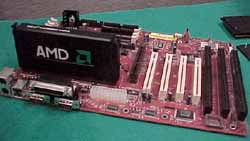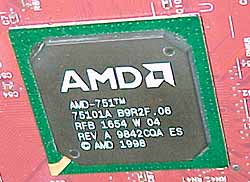Fall Comdex '98 Coverage
by Anand Lal Shimpi on November 21, 1998 11:19 AM EST- Posted in
- Trade Shows
With Intel absent from this year's Comdex, it was AMD's chance to take the show by surprise. While they didn't do so publicly, AnandTech's private meeting with a few officials from AMD proved to be most interesting at the least. Going into Comdex without expecting to see a working K6-3 or K7 demo, I left Las Vegas with a much greater feeling of closure and completeness as both of my dreams for AMD came true with two demos that you'll enjoy hearing about.
The Sharptooth - AMD's K6-3
The first demo AnandTech was given by AMD was of the Sharptooth, a codename for the upcoming K6-3 processor. Featuring the same core as the K6-2 400, with a modification to include a full 256KB of L2 cache running at clock speed, the K6-3 managed to keep up with an equivalently configured Pentium II 450 system while the K6-3 ran at a "meager" 400MHz. According to AMD, as long as your motherboard supports the K6-2 400 (especially in terms of BIOS support), the K6-3 will be nothing more than a chip replacement. FIC has already announced BIOS updates for their MVP3 based motherboards to support both the K6-2 400 and the upcoming K6-3. With the K6-3, any cache outside of the 256KB integrated L2 becomes Level 3 (L3) cache and does add a 3 - 5% increase in overall performance, once again, without requiring a motherboard upgrade. For once, a CPU manufacturer has provided the market with a true upgrade path for their older products, so all of you Super7 advocates owe AMD a huge thanks for not abandoning the market as abruptly as Intel did with their move to Slot-1.
The K6-3 is supposed to be launched in Q1-99, hopefully that launch date will be met, however if history repeats itself, we may be in for a tiny delay before the K6-3 is ramped up to full volume production. Let's keep our fingers crossed.
The Real Beauty of AMD - the K7
As mentioned above, I never expected to be able to see a live demo of AMD's upcoming K7 processor, however to my surprise, AMD had a first revision engineering sample of the K7 up and running in their suite at this year's convention, the results were beyond amazing.
For those of you that don't know, the K7 is an entirely new processor design from AMD, carrying over nothing more than the 3DNow! instruction set from the K6-2/3 predecessors, and abandoning the Socket-7 platform in favor of a slot-based design, called "Slot-A." While the processor is pin-compatible with Intel's Slot-1, architecturally, there is a universe of difference between the K7 and Intel's Pentium II. While the Pentium II uses the P6 bus architecture, AMD's K7 makes use of the Alpha EV6 bus protocol, which is theoretically more advanced than its Intel counterpart. The use of this EV6 protocol is much more than an attempt at rebellion by AMD against the restrictive hand of Intel, but it is also a much larger step towards advancement in technology.
Intended to compete directly with Intel's upcoming Katmai processor, the K7 will have to do much more than boast 3DNow! support to beat Intel at their own game. Comparing KNI (Katmai New Instructions, aka MMX2) to 3DNow! will become much more of an issue once the release date of the Katmai approaches, however now, very little information is available on KNI so any noticeable differences between the two technologies are unknown. One thing does exist in favor of AMD, 3DNow! has been and will be out for a much longer period of time than KNI at the release of both the Katmai and the K7, we'll have to wait and see if that has any effect on the outcome of the AMD/Intel wars of 1999.
The K7 will feature either 512KB or 1MB of L2 cache on the CPU cartridge itself, the stripped down processor looked much like the card inside of a Pentium II's casing, with one peculiar difference, the size of the K7 chip itself (not the card/cache) is about half of the size of the Pentium II's Deschutes core.
In terms of L1 cache, the K7 will have a full 128KB of L1 cache, accounting for a noticeable percentage of its performance lead over an equivalently clocked Pentium II. The K7 will run on a 200MHz EV6 bus and will be the first desktop AMD processor to support multiprocessing, a dream which may soon become reality. In terms of chipset development and support, AMD had their own design for a chipset solution at Comdex, codenamed "Gomez" which featured a North/Southbridge design similar to that of most VIA chipsets. According to AMD, at the launch of the K7 (officially Q2-99), both VIA and ALi should have chipset products ready for shipment and integration into motherboards for the K7.
The demo AnandTech was given featured a 500MHz K7, running at 200MHz x 2.5, with 64MB of PC100 SDRAM (the SDRAM was operated asynchronously to allow for the 200MHz FSB setting), on an AMD Gomez based Slot-A Motherboard, with a Diamond Fusion Z100 3Dfx Banshee video card (don't ask why they chose a Banshee, your guess is as good as mine).
While AMD wouldn't allow AnandTech to obtain any benchmarks from the system, the performance seemed obviously superior to that of a Pentium II 450 in terms of the speed at which it completed Winstone, and 3D Winbench. The K7, if supported properly by motherboard manufacturers (an action that would be nothing but beneficial to manufacturers) can very well become the processor to get in 1999, even with the availability of the Katmai from Intel. With that said, what could possibly be the downfall of the K7? AMD plans to release the K7 in a 0.25 micron version, then later make the transition to a 0.18 micron die size. If we think back to the initial die shrink from 0.35 micron down to 0.25 micron with the K6, numerous delays and yield problems tormented AMD and eventually led to an extremely late release of the highly anticipated K6/266. If the K6/266 had come out when it was announced in November of 1997, AMD would have had an extremely strong competitor against Intel's high priced Pentium II 300, unfortunately the die shrink down to 0.25 micron caused AMD more problems than they had bargained for, and it wasn't until 3 months later that the K6/266 finally hit the retail channels. AMD has a rocky road ahead of them if they plan to release the K7 in Q2 alongside Intel's Katmai, if they can, the consumer will have a huge advantage, as a true competitor to the Katmai should drive prices down incredibly at the launch of both processors leaving you all to choose either AMD or Intel for your next computer. If AMD can't however, it'll take much more than a K7-2 to pull AMD out of another delayed product.













0 Comments
View All Comments